
Many natural enemy adults – particularly tiny wasps and flies – visit flowering plants to obtain nectar and pollen. By providing nectar and pollen, flowers can attract and keep the natural enemies of many pests in the home landscape, enhancing natural or biological control. Some of the many beneficial insects that visit flowers include lady beetles, green lacewings, syrphid flies, tachinid flies, sphecid wasps and various parasitic wasps.
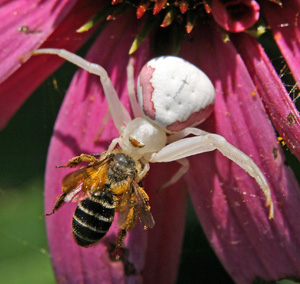
Predatory bugs (such as nabid bugs, minute pirate bugs or twospotted stink bugs) can also be found on flowers, but they’re generally there to feed on thrips or other prey on the blossoms rather than feeding on the flowers themselves. Whether or not planting a specific flower will actually help reduce the abundance of a problematic garden pest depends on how effectively the flower brings in the more effective natural enemies.
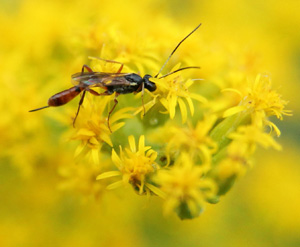
Flowers provide pollen and nectar as a sort of bribe to induce insects to transfer pollen from one flower to the next and cause pollination. However, the size and shape of a flower limit the kinds of insects that can access its pollen and nectar. Many of the natural enemies that can benefit most from floral resources are very tiny wasps, which will get lost in a big flower. The best flowers for these small natural enemies are also small. Many of these small flowers come in big packages that we’d call a single flower, but are actually lots of tiny individual flowers grouped together.
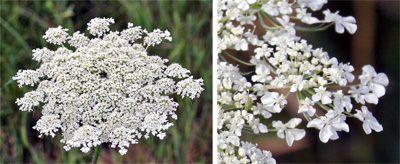
Take a look at a Queen Anne’s lace “flower” – it’s a large inflorescence (an umbel, technically speaking). But to a little syrphid fly, less than ¼ inch long, it’s a smorgasboard of hundreds of tiny nectar-producing flowers. Each individual flower is shallow (not tubular), and has exposed nectaries (although you probably can’t see that!) so it’s easy for the fly to gets its tiny mouthparts to the good stuff. These types of flowers are frequently included in lists of flowers to plant for beneficials, or are in commercially available “insectary seed blends.”

Most of the flowers with these characteristics are concentrated in a few plant families. The Umbelliferae, or carrot family, contains many such species which are frequently included on lists of good plants for insects. Queen Anne’s lace, wild parsnip, fennel, dill, cilantro/coriander, caraway and others are quite attractive to beneficials. All have an inflorescence with lots of tiny, accessible flowers. In an organic market garden in Massachusetts, flowering fennel attracted 48 species of ichneumonid wasps and 8 species of predatory wasps.
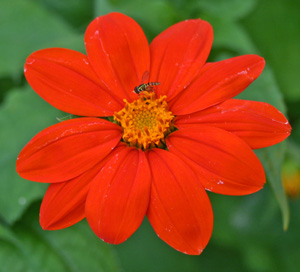
In the Compositae, or aster family, are cosmos, coneflowers, coreopsis, blanket flower and many others. Several types of sunflowers have extrafloral nectaries (nectar-producing glands on stems or foliage) that attract and feed many types of natural enemies. Lettuce or chicory can be left to go to seed for their flowers.
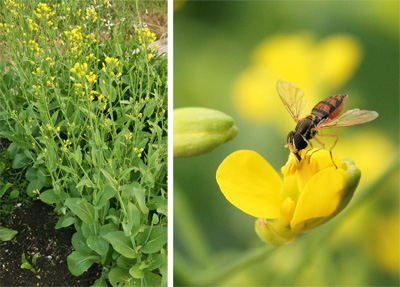
The Brassicaceae, or mustard family includes many common crops such as radish, mustard, arugula, broccoli, and bok choi that can be left to flower after harvest. Sweet alyssum and candy-tufts are common garden flowers in this family that provide useful flowers.
Many legumes that are planted as cover crops, such as white or yellow sweet clover, other clovers, hairy vetch, big flower vetch, alfalfa, and fava beans, are good for natural enemies, not only for their flowers, but as good habitat and a source of alternate prey. Fava beans, like sunflowers, have extrafloral nectaries that attract many natural enemies.
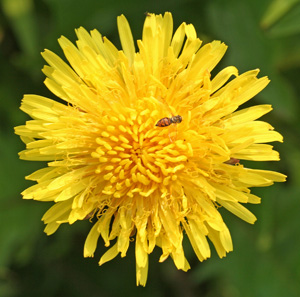
Plants in the family Polygonaceae, such as domestic and wild buckwheats and common knotweed (Polygonum aviculare) are also reported as providing easily-accessible nectar. A number of plant species have been shown to encourage natural enemies (see below), but this list is certainly far from complete. Note that many of these plants are considered weeds!
| Good Flowers For Bugs | ||
| Umbelliferae (Carrot Family) | ||
| caraway | Carum carvi |
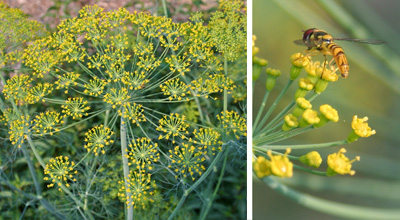 |
| coriander (cilantro) | Coriandrum sativum | |
| dill | Anethum graveolens | |
| fennel | Foeniculum vulgare | |
| flowering ammi or Bishop’s flower |
Ammi majus | |
| Queen Anne’s Lace (wild carrot) |
Daucus carota | |
| toothpick ammi | Ammi visnaga | |
| wild parsnip | Pastinaca sativa | |
| Compositae (Aster Family) | ||
| blanketflower | Gaillardia spp. |
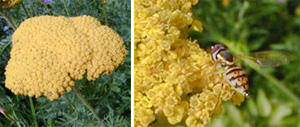 |
| coneflower | Echinacea spp | |
| coreopsis | Coreopsis spp. | |
| cosmos | Cosmos spp. | |
| goldenrod | Solidago spp. | |
| sunflower | Helianthus spp. | |
| tansy | Tanacetum vulgare | |
| yarrow | Achillea spp. | |
| Fabaceae (Bean Family) | ||
| alfalfa | Medicago sativa |
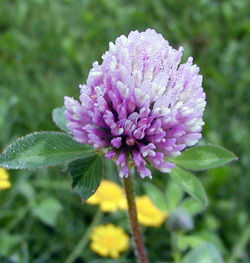 |
| big flower vetch | Vicia spp. | |
| fava bean | Vicia fava | |
| hairy vetch | Vicia villosa | |
| sweet clover | Melilotus spp. | |
| Brassicaceae (Mustard Family) | ||
| Basket-of-Gold alyssum |
Aurinium saxatilis |
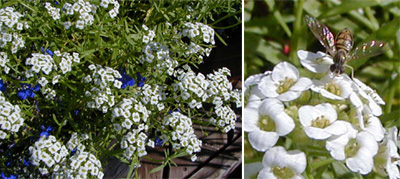 |
| hoary alyssum | Berteroa incana | |
| mustards | Brassica spp. | |
| sweet alyssum | Lobularia maritima | |
| yellow rocket | Barbarea vulgaris | |
| wild mustard | Brassica kaber | |
| Other plant families | ||
| buckwheat | Fagopyrum sagittatum |
|
| cinquefoil | Potentilla spp. | |
| milkweeds | Asclepias spp. | |
| phacelia | Phacelia spp. | |
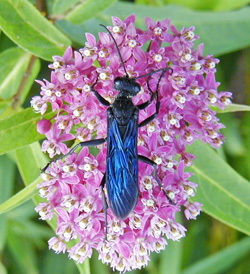
So what exactly makes a good flower – for a bug? A study at Rutgers University used two wasp parasitoids of Colorado potato beetle to explore how flower architecture and nectar scent affect parasitoid attraction and retention. Using artificial flowers, they found that flower nectar greatly increased the time the wasps stayed on the flower, compared with a sugar control. The more concealed the nectar was, the sooner the parasitoids left the flowers. In a garden planted with flowers of varying nectar accessibility, the researchers used a video camera to follow foraging activity of the two wasps. The wasps remained longer on those flowers with the most accessible nectar. Interestingly, they found that on umbelliferous flowers, nectar accessibility was determined not only by both flower morphology, but also by the strength of the wasp. Pediobius foveolatus, the stronger of the two wasps in this study, was better able to spread petals and stamens than Edovum puttleri, and therefore stayed much longer on flowers. It seems that both flower architecture and insect morphology are important in determining what’s a good bug flower.
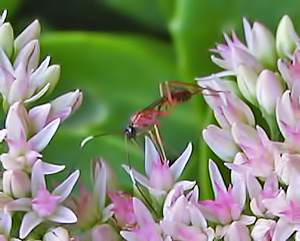
Equally important as flower size and shape is when pollen and nectar are produced by the flowers. Many natural enemy species are around as adults only for short periods during the growing season, so to be useful, pollen and nectar must be available when the adults are active. This is most easily achieved by planting a mixture of plants that have relatively long blooming periods that overlap in time. Perennial plants often have shorter blooming periods than annuals, so particular attention should be given to plant diversity and blooming times in perennial borders designed as habitat for natural enemies. In the home garden, sequential plantings of dill, coriander, and caraway can be made to provide a continuous source of their valuable flowers throughout the season.
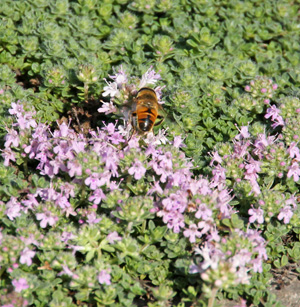
Does planting flowers really increase the number of natural enemies in your yard, and consequently decrease pest problems? Most scientific studies have looked at just the impact of flowers on the longevity and fecundity of many natural enemies, rather than decreases in pest populations. In the few studies that addressed this topic specifically, planting flowers did make a difference. For example, parasitism of bagworms was about 40% higher on shrubs that were surrounded by flowering plants.
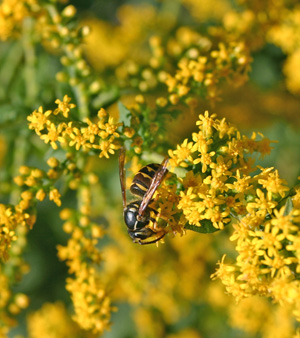
And in one year, plantings of perennial flowers improved parasitism of the summer generation of obliquebanded leafrollers on apple (mainly by the tachinid fly Actia interrupta) but didn’t in another year.
While the idea of prescribing flowers to manage pests has a long way to go, getting home gardeners in the habit of planting more flowers may make it easier to get them to plant the flowers that could help them with pest problems in the future.
– Susan Mahr, University of Wisconsin – Madison





 Marigolds
Marigolds Create a Butterfly Garden
Create a Butterfly Garden Forcing Bulbs
Forcing Bulbs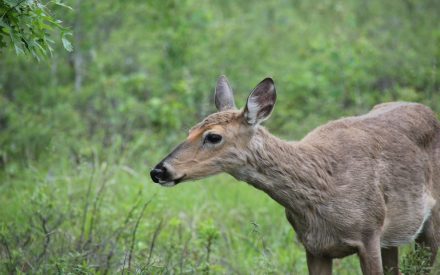 Plants Not Favored by Deer
Plants Not Favored by Deer


